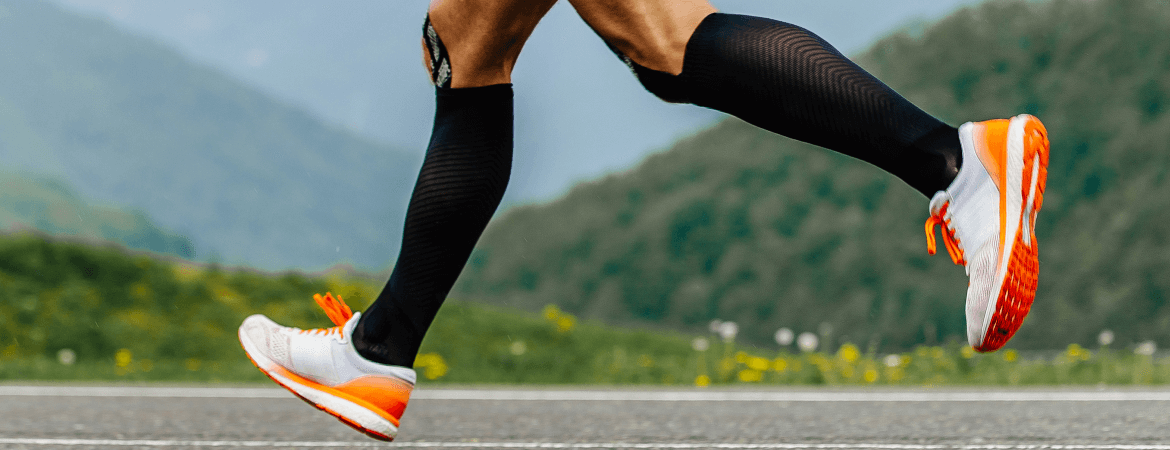
All about compression socks
Do you often experience a heavy, tired or painful feeling in your legs? Compression socks could help.
Also called compression stockings or support socks, these special socks are designed to put pressure on your legs, ankles and feet.
They're tight at the bottom and loosen as they go up your leg. Made from stretchy materials, they provide controlled pressure, helping your blood to flow better.
Who needs compression socks?
- Athletes use compression socks to boost performance, reduce muscle tiredness and speed up recovery by helping blood flow during exercise.
- For long flights or office jobs where you sit a lot, compression socks can stop swelling and discomfort. They're like a shield against deep vein thrombosis (DVT) and leg swelling.
- When pregnancy adds pressure to your legs, causing varicose veins or swelling, compression socks can give you relief and support.
- Doctors often suggest compression socks for people who suffer from varicose veins or blood circulation problems.
- If your job involves lots of standing or sitting, like nursing, waiting tables or office work, compression socks can be your go-to for preventing tiredness and swollen legs, too.
How compression socks can help you
- Promotes blood flow: Compression socks apply pressure on blood vessels, helping the blood flow toward the heart.
- Prevents blood pooling: By preventing blood from pooling in the legs, these socks help reduce the risk of blood clots.
- Controls swelling: The controlled compression of these socks can assist in preventing swelling, especially in the ankles and feet, reducing muscle fatigue and soreness.
- DVT prevention: Recommended for those at risk of deep vein thrombosis (DVT), especially during long flights or if you have a specific medical condition.
- Varicose vein management: Helpful in managing varicose veins, minimising painful symptoms by improving blood circulation and reducing discomfort.
Choosing the right pair
Getting the right pair matters. These socks can go a long way in helping with circulatory issues. Understand your needs and pick the right pair based on compression levels, size, material (and style) for enhanced comfort in your daily life.
Here are some things to consider:
Compression level: Socks come in different pressure levels (measured in mmHg). Mild (15-20 mmHg) is for prevention, and higher levels for medical issues.
Size and fit: Measure your ankle, calf and thigh for the right size. A snug fit (not too tight) is key to the best results.
Material: They're made of various materials like nylon and spandex. Pick the one that feels most comfy for you and meets your needs.
Style/length: Choose from knee-high, thigh-high, or pantyhose style – it depends on your preference, where you need compression, and the intended purpose.
If you still aren't sure about what’s right for you, ask a Medirite pharmacist for help.
Good to know: Venous thrombosis
This condition is a bit like a traffic jam in your blood vessels. Imagine blood flow as cars smoothly cruising along a highway. Now, sometimes, due to various reasons, a clot may form in a vein, causing a bit of a roadblock. This clot is what we call a venous thrombosis.
Then there's "traveller's thrombosis". When you're on a very long flight or car ride, your legs are more prone than usual. In other words, you're not moving around much. This lack of movement can make blood flow sluggish, potentially leading to clots.
So, it's important to try and move around as much as possible, especially in confined spaces. Not everyone has the same likelihood of encountering these blood clots, though. People who have a history of clotting issues, who sit for long periods or have certain medical conditions may be more at risk.
To keep your legs alert and avoid these blood traffic jams, it's all about staying active during travel. Take short walks, do some in-seat exercises and stay hydrated. These simple moves can keep the blood flowing smoothly and help you arrive at your destination with rested legs.
Disclaimer
This article is for informational purposes only. Always check with your doctor or medical practitioner about any health concerns, before embarking on any fitness or nutrition programme, or using any medication.
